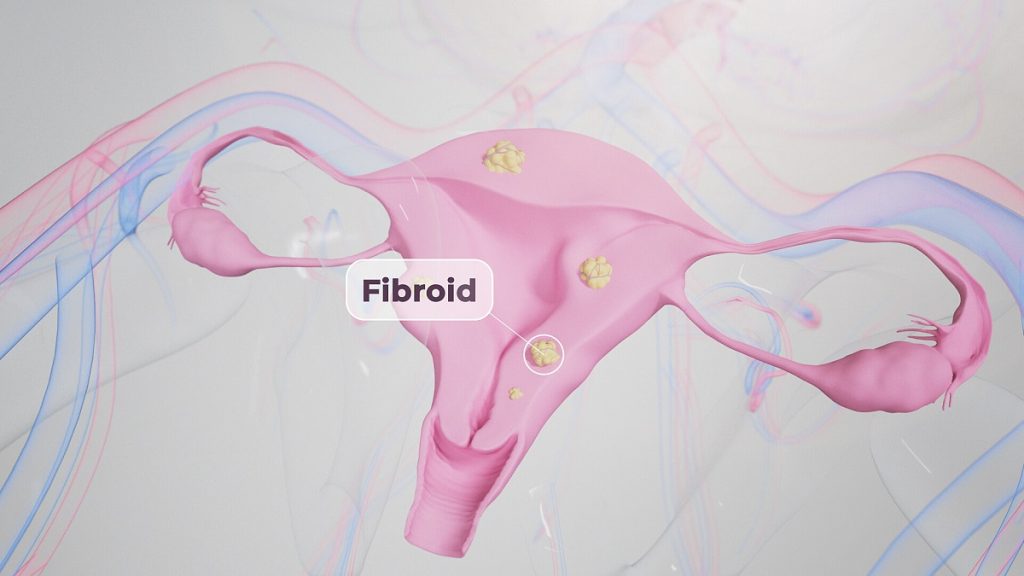
Uterine fibroids are small tumors that develop in and around the walls of the uterus. Fibroids are often benign but can cause heavy periods, abdominal pain, and other symptoms. Treatment options include lifestyle changes, medication, surgery and/or minimally invasive procedures such as Uterine Fibroid Embolization (UFE).
Below you’ll find answers to many of the most common questions about fibroids.
Understanding Fibroids
Transcript
What Are Uterine Fibroids?
Uterine fibroids, also known as leiomyomas or myomas, are growths made of smooth muscle cells and fibrous connective tissue. Women may develop a single fibroid or multiple ones in a cluster, and their size can vary greatly from 1 cm to 8 inches or more.
Where Do Fibroids Grow?
Fibroids may grow on the outside of the uterus or inside the muscle of the uterus. They can also grow into the uterine cavity, although this type of fibroid is rare. Fibroids can also be attached to the uterine wall by a stalk called a peduncle, from either inside or outside the uterus.

Are Fibroids a Type of Cancer?
No, fibroids are usually benign, or non-cancerous.
What Are the Different Types of Fibroids?
Fibroids are categorized based mainly on where they grow:
- subserosal fibroids, the most common type, grow on the outside of the uterus
- intramural fibroids grow in the wall of the uterus beneath the endometrium, the lining of the uterus
- submucosal fibroids grow underneath the endometrium
- pedunculated fibroids grow on a stalk and may be subserosal or submucosal
What Causes Uterine Fibroids?
Doctors have not yet conclusively identified what causes fibroids.
Demographics

What Risk Factors Are Associated with Fibroids?
Risk factors include:
- a history of fibroids in the family
- being deficient in Vitamin D
- being obese
- being childless during childbearing years
- early onset of menstruation (age 11 or younger)
- late onset of menopause (older than 55)
How Common Are Fibroids?
Fibroids are extremely common. As many as 70% of women will develop them during their reproductive years.
Who is Most Likely to Have Fibroids?
Statistically, African American women are more likely to have fibroids, to develop them earlier, to have more or larger fibroids, and to experience more severe symptoms than others. Women whose mother or sister had fibroids are also at increased risk of developing them.
Prognosis & Outlook
Can Fibroids Go Away by Themselves?
Typically fibroids will not go away on their own. Hormonal changes, such as a reduction in estrogen during menopause, can make them shrink but it is rare for them to completely disappear without treatment.
Fibroids can be asymptomatic so it is common for women to have fibroids without knowing it.
Can Fibroids Become Cancerous?
This is possible but rare. Roughly 1 out of 1,000 patients’ fibroids will become cancerous.
Do Fibroids Change Over Time?
There are times when fibroids may grow or degenerate (shrink). For example, elevated hormone levels during pregnancy can cause fibroids to grow, but pregnancy could also cause fibroids to shrink if the blood supply to the fibroids is compromised. Fibroids also stop growing or shrink at the onset of menopause.
Do Fibroids Affect Pregnancy?
Fibroids may be severe enough to hinder fertility or to cause issues during pregnancy, labor, and delivery.
Do Fibroids Need to be Removed?
If they are confirmed to be benign and not causing you any problems, no intervention is needed. However, fibroids that are causing discomfort or affecting pregnancy should be treated.
Diagnosis & Treatment
What Are the Symptoms of Uterine Fibroids?
Any of the following may be an indication of the presence of uterine fibroids:
- heavy periods that last longer than six days or require more than one pad or tampon every hour
- pelvic pain or pressure that may cause feelings of heaviness or bloating
- pain or bleeding during sex
- pain in the lower back
- bathroom issues such as constipation or difficult bowel movements
How Are Fibroids Diagnosed?
If fibroids are suspected, an ultrasound is often used to confirm their size and location. Saline sonography may be used to get a better picture of the exact locations of multiple fibroids and to determine whether they could complicate pregnancy.
MRI and hysteroscopy are two other methods that may be used to diagnose fibroids. MRI is typically used with women approaching menopause or those who plan to treat with uterine fibroid embolization (UFE). Hysteroscopy is more common with women experiencing menstrual issues and infertility.
How Are Fibroids Treated?
Fibroids are treated in three main ways: lifestyle changes, medication, or surgery.
Improving your diet, managing stress, taking supplements, and exercising may be enough to improve fibroid symptoms with no medical intervention needed.
Certain medicines such as birth control, painkillers, and agonists may help with the symptoms of fibroids but will not fully resolve them.
Other treatment options include major operations such as hysterectomy, and minimally invasive procedures such as UFE. Some of these, like UFE, will allow you to preserve your uterus and fertility, while others will not.

When to See a Doctor?
You should consult a doctor if you experience any of the above-described symptoms that cannot be attributed to another identifiable cause.
VasCare Treats Fibroids with UFE
VasCare is proud to offer women across South Texas and Louisiana UFE for help overcoming fibroid issues. A minimally invasive procedure, UFE leaves little to no scarring, has a short recovery time, up to 90% success rate, and keeps the uterus intact.